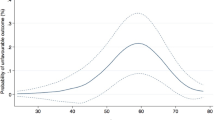Abstract
Penile prosthesis is the treatment of choice for erectile dysfunction (ED) refractory to medical treatment; vasculogenic ED and ED postradical prostatectomy (PRP) are the main aetiologies. Few studies have compared surgical outcomes of penile prosthesis placement for vasculogenic versus PRP severe erectile dysfunction. This study includes 117 cases corresponding to virgin implants for ED of either vasculogenic aetiology or PRP (58 for PRP and 59 for vasculogenic cases). We analysed data corresponding to: age, comorbidity, type of prosthesis, presence of fibrosis that hinders dilation, need for modelling, size of implanted cylinders and complications (intra and postoperative). In the results the rate of hypertension, diabetes, dyslipidaemia and ischemic heart disease was higher in vasculogenic ED. All of the prostheses were hydraulic; 24.1% of two components and 75.9% of three in the PRP group; 39% components of two and 61% of three in the vasculogenic group. With regard to the presence of cavernous fibrosis and need for modelling, no significant differences were found. However, significant differences were observed in the size of the implanted cylinders; PRP of 18.30 ± 2.11 cm versus 19.21 ± 1.71 cm in vasculogenic ED (p = 0.01643). There were no significant differences between the groups in infection rates, mechanical failure or extrusion. In conclusion the implantation of penile prosthesis in ED after PRP is associated with a shorter cylinder length compared with vasculogenic origin. Although there was a certain non-significant tendency to the need for modelling manoeuvres in PRP, there were no significant differences in postoperative outcomes including infection or mechanical failure.
This is a preview of subscription content, access via your institution
Access options
Subscribe to this journal
Receive 8 print issues and online access
$259.00 per year
only $32.38 per issue
Buy this article
- Purchase on Springer Link
- Instant access to full article PDF
Prices may be subject to local taxes which are calculated during checkout
Similar content being viewed by others
References
Das S. Urology in ancient India. Indian J Urol. 2007;23:2.
Small MP, Carrion HM, Gordon JA. Small-Carrion penile prosthesis. Urology. 1975;5:479–86.
Scott FB, Bradley WE, Timm GW. Management of erectile impotence Use of implantable inflatable prosthesis. Urology. 1973;2:80–2.
Atienza Merino G. La prótesis de pene en el tratamiento de la disfunción eréctil. Actas Urol Esp. 2006;30:159–69.
Feldman HA, Goldstein I, Hatzichristou DG, Krane RJ, McKinlay JB. Impotence and its medical and psychosocial correlates: results of the Massachusetts Male Aging Study. J Urol. 1994;151:54–61.
Sanda MG, Dunn RL, Michalski J, Sandler HM, Northouse L, Hembroff L, et al. Quality of life and satisfaction with outcome among prostate-cancer survivors. N Engl J Med. 2008;358:1250–61.
Berookhim BM, Nelson CJ, Kunzel B, Mulhall JP, Narus JB. Prospective analysis of penile length changes after radical prostatectomy. BJU Int 2014;113:E131–6.
Kadono Y, Machioka K, Nakashima K, Iijima M, Shigehara K, Nohara T, et al. Changes in penile length after radical prostatectomy: investigation of the underlying anatomical mechanism. BJU Int 2017;120:293–9.
Fraiman MC, Lepor H, McCullough AR. Changes in penile morphometrics in men with erectile dysfunction after nerve-sparing radical retropubic prostatectomy. Mol Urol. 1999;3:109–15.
Mulhall JP. Penile length changes after radical prostatectomy. BJU Int. 2005;96:472–4.
Ciancio SJ, Kim ED. Penile fibrotic changes after radical retropubic prostatectomy. BJU Int. 2000;85:101–6.
Menard J, Tremeaux J-C, Faix A, Pierrevelcin J, Staerman F. Erectile function and sexual satisfaction before and after penile prosthesis implantation in radical prostatectomy patients: a comparison with patients with vasculogenic erectile dysfunction. J Sex Med. 2011;8:3479–86.
Wilson SK, Delk JR. A new treatment for Peyronie’s disease: modeling the penis over an inflatable penile prosthesis. J Urol. 1994;152:1121–3.
Gontero P, Galzerano M, Bartoletti R, Magnani C, Tizzani A, Frea B, et al. New insights into the pathogenesis of penile shortening after radical prostatectomy and the role of postoperative sexual function. J Urol. 2007;178:602–7.
Briganti A, Fabbri F, Salonia A, Gallina A, Chun FK-H, Dehò F, et al. Preserved postoperative penile size correlates well with maintained erectile function after bilateral nerve-sparing radical retropubic prostatectomy. Eur Urol. 2007;52:702–7.
Akin-Olugbade O, Parker M, Guhring P, Mulhall J. Determinants of patient satisfaction following penile prosthesis surgery. J Sex Med. 2006;3:743–8.
Deveci S, Martin D, Parker M, Mulhall JP. Penile length alterations following penile prosthesis surgery. Eur Urol. 2007;51:1128–31.
Author information
Authors and Affiliations
Corresponding author
Ethics declarations
Conflict of interest
The authors declare that they have no conflict of interest.
Additional information
Publisher’s note Springer Nature remains neutral with regard to jurisdictional claims in published maps and institutional affiliations.
Rights and permissions
About this article
Cite this article
Cocera, R., Torremade, J., Suarez, J.F. et al. Comparative analysis of penile implants in patients with vasculogenic erectile dysfunction versus postradical prostatectomy erectile dysfunction. Int J Impot Res 32, 606–610 (2020). https://doi.org/10.1038/s41443-019-0198-8
Received:
Revised:
Accepted:
Published:
Issue Date:
DOI: https://doi.org/10.1038/s41443-019-0198-8


